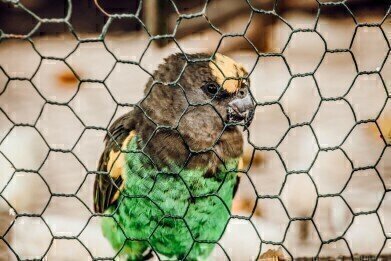News & Views
The Riddle of the Bird in the Cage is Finally Put to Bed
Feb 22 2015
It’s a riddle that has had physicists stumped for decades – and even inspired an episode of the popular TV series Mythbusters – but scientists from Stanford University appear have finally cracked it… with results which contradict those found on the show.
The question of whether or not a cage containing a bird would be lighter while the bird is in flight is one that has had the scientific world scratching its head for some time. How to go about verifying the answer? Mythbusters took the direct approach of weighing a truck full of birds, both while stationary and in flight, and found that the scales did not show much variation in the results.
However, Professor David Lentink and his team at Stanford have developed an ultra-sensitive device which is able to measure the weight of a bird’s body, even while it is in flight… and the results are surprising, to say the least.
Not Sensitive Enough
The scales used on the television programme were not able to detect such subtle variations in the weight of the avian, especially since this weight changes with every single up and down stroke of its wing – and at several different rates each second.
To surmount the problem, Prof Lentink and his team created an insulated box with measuring scales on all of the interior walls, which are capable of detecting fluctuations in the air pressure inside the box up to 100 times per second.
In this manner, the team discerned that on the upstroke of the bird’s wings, they were generating almost zero upward force, which, in effect, means that the birds are temporarily weightless.
However, on the downstroke, they were required to push so forcefully with their wings as to create almost twice their body weight in force. As a result, their weight effectively changes from zero to double their actual weight several times each second. Of course, in a cargo full of birds flapping profusely, the law of averages means that this will even out over the whole flock and produce results such as those seen in the TV show.
Were the birds all to flap their wings at precisely the same time and rate, however, the truck would weigh the same as if it was empty – and then the same as if it were filled with twice the amount of birds.
Another Mystery Solved
The fascinating research not only solves the age old conundrum, but the technology involved in the hyper-sensitive scales could also be put to practical use in the drone industry. Due to their not being affected by changes in the subject’s centre of gravity, the scales could provide valuable insight into the aerodynamics of winged drones that has been previously unavailable.
It’s not the first team that Stanford University has used animal research to benefit other spheres, either. In 2011, the article Fur Trade Provides Insights into TB discussed how the study of animal fur could provide helpful knowledge into how the killer disease tuberculosis spreads among its victims.
Meanwhile, scientists from the same institute found the following year that making lab mice comfortable had a positive effect on test results, since circumstances like body temperature affected how they reacted to drugs and treatments. It seems there is much we can learn from our furry friends in the animal kingdom – and Stanford University is at the forefront of accruing such knowledge.
Digital Edition
Lab Asia 31.2 April 2024
April 2024
In This Edition Chromatography Articles - Approaches to troubleshooting an SPE method for the analysis of oligonucleotides (pt i) - High-precision liquid flow processes demand full fluidic c...
View all digital editions
Events
May 05 2024 Seville, Spain
InformEx Zone at CPhl North America
May 07 2024 Pennsylvania, PA, USA
May 14 2024 Oklahoma City, OK, USA
May 15 2024 Birmingham, UK
May 21 2024 Lagos, Nigeria











.jpg)






